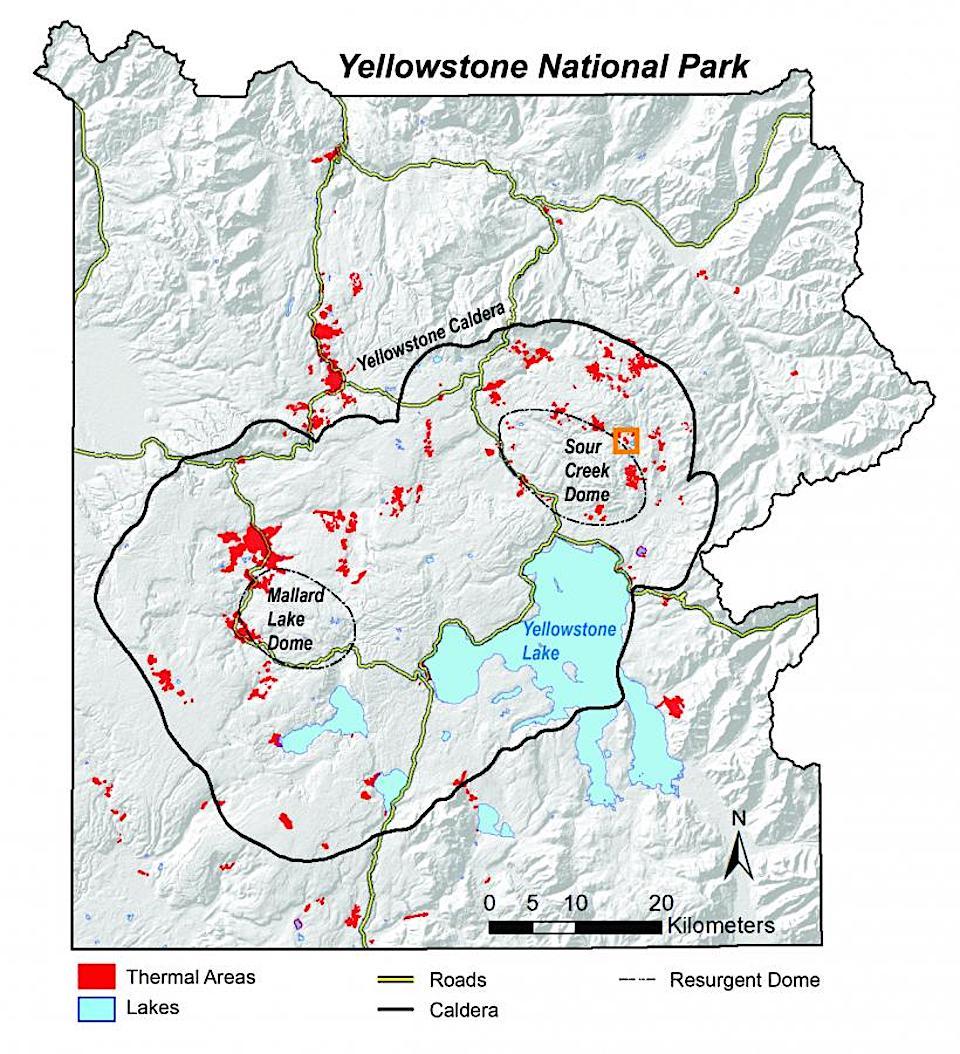
Map of thermal areas in Yellowstone National Park. Most of Yellowstone's more than 10,000 thermal features are clustered together into about 120 distinct thermal areas (shown in red). Lakes are blue. The Yellowstone Caldera is solid black and the resurgent domes are dotted black. Roads are yellow. The orange box shows the location of the Tern Lake thermal area/USGS
High above the roadway between Norris and Madison in Yellowstone National Park is a wheezing thermal area seemingly on its last gasp. The Monument Geyser Basin is heading towards dormancy, and draws comparatively little attention from visitors. But as it continues to fade, another thermal area is emerging in the park, the first entirely new area discovered in the park in 20 years, according to scientists.
According to the Haynes Guide Handbook of Yellowstone National Park written by Frank Haynes in 1910 (with numerous revisions down through the years), "One of the most striking features of this area is Monument Geyser, which erupts almost steadily 4 to 9 feet high. It is a spraying geyser having a cylindrical cone 6 or 8 feet high."
The basin was discovered in 1878 by P.W. Norris, according to an entry in Yellowstone Place Names by Lee Whittlesey. Whittlesey, the park historian, notes that the basin "was once a major tourist attraction with 12 monumental cones and features named "Sulphur Cone" and "Trip Hammer." In his 1883 guidebook, Henry R. Winser said one of sinter formations "resembles a crouching lioness; another, a headless man; a third, like a slender chimney, pours out a cloud of smoke; a fourth whistles like a locomotive; a fifth belches out steam with a whizzing sound which is quite deafening as you stand by, and is audible for miles."
Today, though, the basin is not as furious as it once was, and it would require a vivid imagination to see what Mr. Winser did. None of the basin's features spouts streams of boiling water. Rather, they fume and hiss and spout tendrils of smoke carried this way and that on the breezes. But the setting, so high above the valley floor and squeezed on the ridgeline, is unlike any other occupied by a geyser basin in Yellowstone.
While Monument Geyser Basin might be heading towards extinction, a new thermal area in the backcountry of the park has been spotted thanks to recurring infrared satellite imagery. According to the staff at the Yellowstone Volcano Observatory, Landsat-8 nighttime thermal infrared image acquired in April 2017 "revealed an unexpected warm area between West Tern Lake and the previously mapped Tern Lake thermal area."
This image "reveals a large area of dead trees and bright soil, rather like a thermal area. ... (I)magery from 2006 shows a smaller zone barren of vegetation and the beginnings of a tree kill zone with many reddish-brown trees among healthy green ones. The 1994 air photos, while black and white and lower spatial resolution, clearly show that this was once an area of healthy trees with no hint of a thermal area. Other historical imagery that have been analyzed indicate that this thermal area started forming in the late 1990s or early 2000s. It is also notable that between 2006 and 2017 there was an increase in the size of the tree kill zone on the north side of the previously mapped Tern Lake thermal area."
"From all these satellite and aerial images, we conclude that a new thermal area has emerged in the past 20 years!" wrote R. Greg Vaughan, a research scientist with the U.S. Geological Survey, in a recent edition of the Yellowstone Caldera Chronicles. "The newly emerging thermal area, located at 44.6635° N latitude, 110.279° W longitude, can be seen using Google Earth. In fact, using the time slider tool in Google Earth, one can see how this area has changed since 1994—you can see the changes in the vegetation and the emergence of the thermal area yourself!"
Visiting the area in person would be trickier. According to the YVO staff, "this area is deep in Yellowstone's back county, about half a mile (0.8 kilometers) from the nearest trail, and about 11.2 miles (18 kilometers) from the nearest trailhead."
"The recognition of the new thermal area is a great example of the importance of satellite thermal infrared imaging—especially images acquired at night—for mapping Yellowstone's thermal areas (including both the discovery of new hot spots and changes in existing areas)," he added. "This is exactly the sort of behavior we expect from Yellowstone's dynamic hydrothermal activity, and it highlights that changes are always taking place, sometimes in remote and generally inaccessible areas of the park."



Comments
"Discovered in 1878?" not likely. Native Americans had been on the continent for over 10,000 years by then.
Agreed, in fact if you go back, say 63 million years and read up on the "Dino cronicals", to may find that even the T-rex used the hot pools to warm up after a long ice age.